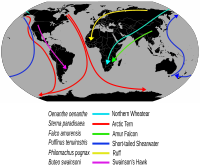
Photo from wikipedia
Abstract Songbirds have evolved diverse strategies to cope with seasonality, including long‐, medium‐, and short‐distance migration. There is some evidence that birds with a longer migration distance deposit fuel faster.… Click to show full abstract
Abstract Songbirds have evolved diverse strategies to cope with seasonality, including long‐, medium‐, and short‐distance migration. There is some evidence that birds with a longer migration distance deposit fuel faster. However, most studies focus on long‐distance migrants. Comparisons between species with different migration distances are necessary to broaden our understanding of fueling capacity in migratory birds. We present maximum fuel deposition rates of five songbird species migrating along the southeast coast of Sweden in autumn with migration distances ranging from long (neotropical migrant) to short (partial/irruptive migrant) (Willow Warbler Phylloscopus trochilus, Lesser Whitethroat Curruca curruca, Common Chiffchaff P. collybita, European Robin Erithacus rubecula, and Blue Tit Cyanistes caeruleus). The birds were fed ad libitum in captivity and were exposed to either extended or natural daylength. All species ceased to increase in mass when they reached a certain fuel load, generally corresponding to migration distance, despite unlimited access to food and ample time for foraging. Blue Tits, Willow Warblers, and Lesser Whitethroats had the highest fuel deposition rates with extended daylength (19%, 20%, and 20%, respectively), and about 13% with natural daylength, which is comparable to the highest rates found in migratory songbirds in nature. European Robins and Common Chiffchaffs that winter in the temperate Mediterranean had the lowest fuel deposition rates (12% and 12% with extended daylength, respectively). Our results suggest that the long‐ and short‐distance migrants in this study have developed an extreme capacity for rapid refueling for different reasons; speedy migration to distant wintering grounds or winter survival in Scandinavia. This study contributes to our current knowledge of maximum fuel deposition rates in different species and the limitations posed by daylength. We highlight the need for future studies of species with different migration strategies in order to draw broad conclusions about fueling strategies of migratory birds.
Journal Title: Ecology and Evolution
Year Published: 2023
Link to full text (if available)
Share on Social Media: Sign Up to like & get
recommendations!